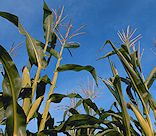November 13, 2009

FAQ: USDA's new CSP program offers a continuous sign-up, so why did farmers have to inform NRCS by September 30 if they wanted to participate?
Answer: By Mike Duffy, Iowa State University Extension farm economist.
USDA's Conservation Stewardship Program (CSP) is a new program in the 2008 Farm Bill. It replaces the previous program which was called the Conservation Security Program. The acronym for the new program is the same as for the old program—CSP--but the two programs are entirely different.
The new program is available statewide and will offer payments to farm operators based on additional conservation measures they adopt for at least five years.
CSP is a continuous sign-up program but Sept. 30, 2009 was the deadline for the first ranking of applications to determine their eligibility for payments. You can go to your local NRCS office and find out more information about CSP and apply for the program at any time. NRCS will announce when the cutoff date is for applications to be included in the next ranking period.
Applications to enroll in CSP evaluated, ranked
Under the new CSP the farm operator works with an NRCS conservationist and discusses the conservation practices the farmer currently uses and the ones the farmer intends to adopt. The current practices determine eligibility for CSP and they count in the final ranking for the farm operator.
The conservation practices considered in determining your ranking are those that affect the primary resources of concern for Iowa. These resources are water quality, air quality, soil quality and animals. The list of practices includes such things as injecting or incorporating manure, dust control on unpaved roads, extending existing filter strips, recycling farm lubricants and going to no-till. There are many other practices for cropland, pasture and forest.
A "Conservation Measurement Tool" is used
The NRCS conservationist and the farm operator go through the practices using the Conservation Measurement Tool developed by NRCS. The farmer must meet a minimum conservation standard to be eligible for the CSP; andthe farmer must be adding new conservation practices.
After evaluating the existing practices and the proposed new practices, the farm operator will be assigned a point total based on these practices. The operators are ranked onthe basis of their point total. Those operators with thehighest number of points will be eligible for the CSP program's per acre payments.
Currently we do not know the exact payment per acre. However, NRCS has estimated nationwide that payments will be somewhere between $12 and $22 per acre. A payment close to $16 per acre will be the most likely outcome.
Factors to consider before deciding to apply
There are a few things an individual farmer should remember when considering applying to enroll in the CSP:
The contracts are for five years.
All of your owned and operated land must be included.
If rented land is to be considered as part of the operation, the producer must show proof of control for at least five years.
Payments are based only on acres considered part of the operation.
There can be no double payments for existing land under a conservation payment program. For example, land in CRP, WRP or EQIP would not be eligible for a CSP payment.
You must add some new conservation practices
There has to be at least some new conservation practices added. Existing practices will be factored into the ranking and will affect the operator's payment. The final ranking for the various practices has not been determined, but, the operator was required to notify NRCS that the operator would like to apply for the program by Sept. 30, 2009.
This was the cutoff date to be considered in the first ranking. The operator will be notified when that ranking has been completed and when the operator should schedule an appointment with the NRCS conservationist.
You are encouraged to use self-screening test
NRCS has developed a self-screening checklist for farm operators to determine if the Conservation StewardshipProgram is a good program for them. All producers should complete the checklist. This is a good tool to help them decide if they are eligible and should pursue the CSP program. The checklist and other information about the Conservation Stewardship Program are available at NRCS county offices or online at http://www.ia.nrcs.usda.gov/programs/csp2009.html.
In addition to the annual payments there is a special provision in CSP for the farm operator to receive a onetimepayment for a resource-conserving crop rotation.
Special provision for one-time bonus payment
A resource conserving rotation must be at least three years and include a high residue crop, a cover crop or some type of perennial grass for at least one-third of the acres. This rotation must be new to the operation. CSP will provide an additional payment to the farm operatorfor adopting this rotation.
For more information on the CSP you should visit the NRCS Web site or your local NRCS office. Although the initial sign-up deadline was Sept. 30, 2009, continuous sign-up is available by letting the NRCS know of your intent as a farm operator to apply. This will be the application--the interview with the NRCS conservationist will be scheduled for a later date.
If you have specific questions or need details regarding USDA farm programs, contact your local USDA Farm Service Agency office. You can also get news and information about DCP, ACRE and other USDA programs at www.fsa.usda.gov.
Two Iowa State University Extension Web sites have farm program information and analysis. They are ISU's Ag Decision Maker site at www.extension.iastate.edu/agdm and ISU Extension Specialist Steve Johnson's site at www.extension.iastate.edu/polk/farmmanagement.htm.
And be sure to read the regular column "Frequently Asked Questions about the Farm Program" that appears in each issue of Wallaces Farmer magazine and at www.WallacesFarmer.com
You May Also Like




